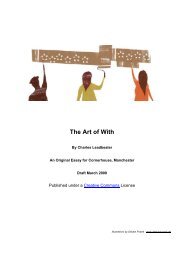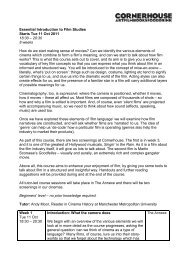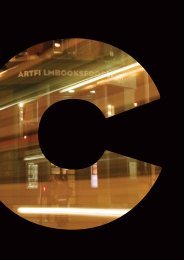Indian Cinema: The World's Biggest And Most ... - Cornerhouse
Indian Cinema: The World's Biggest And Most ... - Cornerhouse
Indian Cinema: The World's Biggest And Most ... - Cornerhouse
Create successful ePaper yourself
Turn your PDF publications into a flip-book with our unique Google optimized e-Paper software.
Image : <strong>The</strong> Namesake (2006)<strong>Indian</strong> <strong>Cinema</strong>: <strong>The</strong> World’s<strong>Biggest</strong> <strong>And</strong> <strong>Most</strong> Diverse Film IndustryWritten by Roy Stafford
<strong>Indian</strong> <strong>Cinema</strong>What is ‘<strong>Indian</strong> <strong>Cinema</strong>’?It ought to be straightforward to present a description of the ‘world’s biggest film industry’, but even <strong>Indian</strong>film scholars find it difficult to come to terms with its diversity and seeming contradictions. <strong>The</strong> biggestsingle mistake that non-<strong>Indian</strong> commentators (and some <strong>Indian</strong>s) make is to assume that ‘Bollywood’ isthe same thing as <strong>Indian</strong> <strong>Cinema</strong>. It isn’t.Consider the sheer size of India. Roughly as big as Western Europe (but with four times the population),it includes two major ethnic groups, two large and several smaller religious communities (including theworld’s third largest Muslim population) and an enormous range of languages (several hundred).2
<strong>Indian</strong> <strong>Cinema</strong><strong>The</strong> size of the country is matched by a longstanding love affair with cinema which creates the world’sbiggest film audience. Even though India was controlled by the British until 1947, this did not preventthe development of ‘industrial’ film production in several <strong>Indian</strong> cities, so that by the late 1930s an <strong>Indian</strong>‘studio system’ was in place. By the late 1990s, India had overtaken Japan and America as the producerof the largest number of feature films per year (800-1,000) and with an annual audience of over 3 billion athome and millions more overseas, it can also claim to be the most popular.All of this is not disputed, but when we come to look at the films themselves and who watches them, itgets more complicated. India is now famous for its computer software engineers and it has always beenknown for its bureaucracies (needed to organise the world’s largest democracy), but the film industryin India is only slowly beginning to deliver the detailed box office information on a regular basis thatbusiness commentators and film scholars in the UK and North America have come to expect from theirown industries. <strong>The</strong>re are rapid changes taking place in the <strong>Indian</strong> entertainment business with modernmultiplexes appearing in big cities – but also many traditional cinemas in small towns in rural areaswhich do not have the industry infrastructure to make data collection straightforward. So, we must becircumspect in trying to describe the industry as it exists now – and we must recognise that it is changingall the time.Four cinemasOne way to think about <strong>Indian</strong> <strong>Cinema</strong> is to distinguish four categories (but note that these all overlap andthe boundaries between them are not fixed):• Popular Hindi <strong>Cinema</strong>• Regional cinemas• ‘Art’ or ‘specialised’ cinema• Diaspora cinema (films made by <strong>Indian</strong> filmmakers based overseas)We can best understand the importance of these classifications by making two simple distinctions.<strong>The</strong> first is between ‘popular’ and ‘art’ cinema. <strong>The</strong> massive popular audience in India is hungry forcheap entertainment and this is what cinema has provided. This audience, which includes a significantproportion of people with limited access to education, enjoys universal genres such as action, comedyand melodrama and more specifically ‘<strong>Indian</strong>’ stories with spiritual/mythological themes. <strong>The</strong> typical <strong>Indian</strong>film as viewed from outside the country may well be a three hour spectacular ‘multi-genre’ film with six orseven extended elaborately choreographed and costumed musical sequences.But there is also an <strong>Indian</strong> audience for more ‘serious’ film narratives, akin to European, Japanese andAmerican ‘art’ cinema and indeed to more adventurous Hollywood films. This audience is relatively small,but because the overall audience is so large, even a small proportion means significant numbers. It tendsto be an audience concentrated in the major cities, especially in the two states with the greatest culturaltraditions, West Bengal and Kerala, and in the centres for higher education and new technologies in Delhi,Mumbai, Bangalore, Hyderabad etc. For many years from the 1950s to the 1980s, it was the Bengaliart film director Satyajit Ray who represented <strong>Indian</strong> <strong>Cinema</strong> to the outside world. In the 1970s <strong>Indian</strong><strong>Cinema</strong> developed a more socially aware and more politically orientated form of cinema, partly subsidisedby public funding, which was known as Parallel <strong>Cinema</strong> – running alongside but clearly distinguishedfrom mainstream cinema. Since the 1990s and the opening up of the <strong>Indian</strong> market to private investors athome and overseas, this political cinema has gone into decline, but to some extent the tradition of ‘sociallyaware’ films has been supported by <strong>Indian</strong> filmmakers such as Mira Nair and Deepa Mehta who havereturned to India to make films using their training and experience gained in North America (respectivelythe US and Canada). This ‘diaspora cinema’, often, but not always, means art cinema.3
<strong>Indian</strong> <strong>Cinema</strong><strong>The</strong> second distinction (which cuts across the first) is between Hindi <strong>Cinema</strong> and Regional <strong>Cinema</strong>s.Hindi is the official language of the Union of India. However only around 40% of <strong>Indian</strong>s actually speakHindi. In the North of India, variations of Hindi are spoken as a first language by the population of severalstates around Delhi. Other North <strong>Indian</strong>s whose first language might be Gujerati, Punjabi, Bengali etc.can also access Hindi films, as can Urdu speakers in Pakistan. All these languages are part of the sameIndo-European group. But in the South of India, the language family is completely different and Tamils inparticular have in the past objected very strongly to the suggestion that Hindi should be the only officiallanguage of the country. As a result, English has been retained as India’s second official language and inthe South, the different regional language cinemas have the support of the mass of the population. Hindi<strong>Cinema</strong> in the South is only accessible by the more educated part of the population and Hindi films aredistributed in a similar way to Hollywood films – i.e. available only in a minority of cinemas.BollywoodTo give you a sense of the range of filmsmade in India, here is a breakdown of filmsin different languages for 2003 (the latestdate available) taken from the website ofthe Central Board of Film Certification (the<strong>Indian</strong> equivalent of the BBFC).Hindi: 222Tamil: 151Telugu: 155Kannada: 109Malayalam: 64Bengali: 49Marathi: 25English: 23Assamese: 17Others: 62Total: 877<strong>The</strong> four Southern film industries in TamilNadu, <strong>And</strong>rha Pradesh (Telugu), Karnataka(Kannada) and Kerala (Malayalam) producemore than half the total number of <strong>Indian</strong>films. This isn’t surprising because the Southhas more cinemas and a higher per capitacinema attendance than the North.So, where is Bollywood in all this? <strong>The</strong> term ‘Bollywood’, which is often taken to be a contraction of‘Bombay Hollywood’, is a fairly recent term as used by film scholars and film industry commentators. It isstill criticised as meaningless by some, but it began to circulate from the 1980s onwards and is now widelyused in India and across the world.Bollywood is much like Hollywood in the number of films it produces – around 200 per year (i.e. the maincomponent in the Hindi total above). It is also like Hollywood in that its films tend to have the highestmedia profiles, sometimes the biggest budgets and stars and a reputation for ‘modern’ entertainmentvalues. <strong>The</strong> crucial difference between Bollywood and its regional competitors is that Bollywood hascreated an artificial culture that appeals to a specific audience found across India – whereas the regionalcinemas are firmly rooted in their own language and culture. It wasn’t always the case that the big budgetHindi films (originally produced in studios in Calcutta and Pune as well as Bombay) were divorced from4
<strong>Indian</strong> <strong>Cinema</strong>social reality. Indeed, the ‘social film’ wasonce an important genre. It was the successof big action pictures such as Sholay (1975)that started the trend towards multi-genrepictures, which increasingly began to drawon Western modes of presentation. In 1998the very successful Kuch Kuch Hota Hai wasdescribed by some critics as being influencedby MTV and Western youth culture references.This trend towards a less social realistic cinemaand one more associated with consumeristfantasy was also associated with the rise ofthe NRI (Non-Resident <strong>Indian</strong>) audience in theUK and North America. This audience is ableto pay much higher ticket prices than those inIndia (where some tickets are still below 50p)and this income from exports helps Bollywoodproducers to offset box-office flops at home.Image : Sholay (1975)<strong>The</strong> export of films has been a feature of <strong>Indian</strong> <strong>Cinema</strong> for a long time. <strong>Indian</strong> films have been shown inthe UK since the late 1940s and by the 1970s there was a circuit of cinemas regularly showing Hindi filmsin the UK to eager audiences (see Tyrrell 1998). This market then transferred to video until the return ofHindi films in UK multiplexes in the 1990s. In Africa, the Middle East and many other territories, Hindi filmshave long competed with Hollywood and Hong Kong for popular audiences. This has usually meant lowticket prices, but here too there is a move towards higher prices in newer cinemas where an NRI audiencemight exist (e.g. in Kenya, South Africa and the Gulf States).<strong>The</strong> ‘artificiality’ of Bollywood is partly to do with its production practices. Its films are made in Hindi inMumbai where the local language is Marathi and where there is also a Marathi regional cinema industry.Spectacular dance sequences are often filmed in ‘exotic’ locations that are beautiful or famous, ratherthan because the location has any relevance in the narrative. So the locations may be in any part of India,the pyramids in Egypt, Mauritius, Switzerland, Scotland and, increasingly now, London. NRI audiencesare now coming to terms with representations of London that appear strange to UK audiences. Moreimportantly perhaps Bollywood films have tended not to specify where a story is set or to refer directlyto <strong>Indian</strong> politics or religious/cultural differences. This way they are more escapist and less potentiallydisturbing.Regional cinemasIn the South, popular films are more recognisably ‘about’ local culture. For a long time, audiences in thestates of <strong>And</strong>rha Pradesh and Tamil Nadu have been aware of a very close relationship between filmand politics – but in a uniquely <strong>Indian</strong> way. Some of the biggest film stars in these states have also beenpoliticians and film fan clubs have often been political organisations as well. <strong>The</strong> popularity of someregional films is such that they can sometimes bypass Bollywood films at the box office, just by sellingtickets in their home state. In 2005, the biggest box office film in India was Chandramukhi made in Tamiland featuring Rajnikanth, India’s biggest star. Rajnikanth is now 57 and he has decided to work on onlyone film at a time. His 2007 film Shivaji looks likely to be India’s biggest box office title of the year again.It was the first non-Bollywood <strong>Indian</strong> film to make the UK Top Ten, even though it only played on 12screens. Although Tamil films do find an audience overseas, this is mostly in countries like Malaysia andSingapore, but DVD has made it easier to reach the Tamil diaspora across the world (around 12 millionwith a home market of around 65 million -- larger than the UK market).Tamil films are made in Chennai (formerly Madras), which is also a location for some of the films madein Telugu, Kannada and Malayalam. Chennai plays a major role in post-production, including servicesused by Bollywood and it can make a claim to be the real <strong>Indian</strong> film capital, ahead of Mumbai. Much asin Europe in the 1920s, South <strong>Indian</strong> films are often made in two language versions (i.e. Tamil and Telugu5
<strong>Indian</strong> <strong>Cinema</strong>-- there are over 75 million Telugu speakers). This relationship also extends to Bollywood, so that Tamil/Telugu films may be dubbed into Hindi for distribution in North India and Hindi films may be dubbed intothe Southern languages. Remakes are also common between the regional cinemas themselves and withBollywood. Chandramukhi (described by IMDB as a Comedy/Fantasy/Horror/Musical/Romance) was abigger budget remake of a Malayalam film.<strong>The</strong> four South <strong>Indian</strong> regional cinemas together constitute a major film industry which can competewith Bollywood. Regional cinemas outside the South tend to be smaller and not to have such a largeproduction base. In cultural terms, Bengali cinema is still important and films made in Bhojpuri, a variationof Hindi (its linguistic roots are contested) widely spoken in Bihar and surrounding states, have sometimesproved to be very popular.<strong>The</strong> <strong>Indian</strong> film industry is always changing and as traditional cinemas close in the South and moremultiplexes open, there may be a shift towards Bollywood. But the South is building multiplexes too andit is worth noting that Hollywood distributors have started to release films in India dubbed into severallanguages. In 2007, Spider Man 3 did very well in Chennai (opening on a digital print in a new multiplex)and the narration for the film March of the Penguins was dubbed into Telugu and Tamil as well as Hindi.Case Studies<strong>The</strong> Career Of Mani RatnamFor many commentators, and many <strong>Indian</strong> filmfans, the most interesting filmmaker in India isMani Ratnam. He began writing and directing in1983, making films in Kannada and Malayalamas well as Tamil, his native language. He mostlyproduces his own films and in 1987 Nayakan,a ‘Godfather-like’ take on Tamil crime andcelebrity was a big regional hit. But it was in1992 with Roja, the first of a trilogy of romancefilms firmly rooted in political issues, that ManiRatnam became a national figure with a filmthat has since been seen as marking a turningpoint in <strong>Indian</strong> <strong>Cinema</strong>.Roja was a Tamil film, dubbed into Telugu,Malayalam and Marathi as well as Hindi.<strong>The</strong> Hindi version was a big hit and changedRatnam’s career. Roja contradictedassumptions about regional films and theirappeal to Bollywood audiences. <strong>The</strong> title refersto a young village woman in Tamil Nadu, whofinds herself married to a middle-class manworking in military software. (<strong>The</strong> man wassupposed to marry her sister, but recognisingImage : Mani Ratnamthat the older sister was in love with someoneelse, chose the younger.)When the husband is sent on a mission to help the <strong>Indian</strong> Army in Kashmir fighting separatists, the youngwife insists on going with him and when her husband is kidnapped, she does everything she can to goadthe authorities into getting him back alive.Roja takes Tamil cinema out of the South and shows a national audience a real ‘national issue’, presentedin the universal story of a young, uneducated village woman up against political and military authorities6
<strong>Indian</strong> <strong>Cinema</strong>and ‘human’ ‘freedom fighters’ dealing with a captive who is by no means prepared to lie low. <strong>The</strong> filmis exciting with high quality widescreen photography by Santosh Sivan from Kerala, one of the mostdistinguished cinematographers (and directors) in India, and music by A. R. Rahman, another Southernerwho has since become internationally famous.After Roja and its focus on Kashmiriseparatism, Ratnam turned to the equallycontentious issue of ‘communalism’ – theconflict between Hindus and Muslims inIndia. Bombay (1995) sees a Hindu man anda Muslim woman marrying and because ofhostility in their village, moving to Mumbaiwhere two children are born and the family ishappy in a more secular atmosphere. But afterthe attack on a mosque in Ayodhya (a realevent with repercussions across India), thefamily are torn apart during communal riots.Although structured as a traditional melodrama/romance, the social issue is paramount. As onecontributor to the IMDB entry on the film putsit: “An underlying moral of thinking of oneselfas an <strong>Indian</strong> rather than a Hindu or a Muslim isprevalent throughout the latter part of the film”.Image : Bombay (1995)Bombay was still a Tamil film, subsequently dubbed into Hindi and again a national success. In 1998 ManiRatnam made his first Hindi film, still with his South <strong>Indian</strong> creative team of A. R. Rahman and SantoshSivan, but this time with Bollywood superstar Sharukh Khan in the lead. Dil Se is in some ways thereverse of Roja, featuring a romance between an All-India Radio reporter (Sharukh Khan) and a youngwoman (Manisha Koirala) he meets fleetingly on a railway platform. <strong>The</strong> reporter follows the woman toAssam in North East India where she is revealed as a ‘freedom fighter’ – and where the couple fall inlove. In the final section of the film, the action moves to New Delhi where the reporter faces an arrangedmarriage and the freedom fighter plans to disrupt the celebrations on India’s National Day (in 1997, the50th anniversary of India’s independence).Sharukh Khan’s presence should have guaranteed a box office hit, but the film did poorly in India, despitebeing dubbed into Telugu and Tamil. However, overseas it was a big hit with NRI audiences, becoming thefirst Bollywood film to make the UK Top 10. Its breathtaking musical sequences included the song ‘ChaiChaiyya, Chaiyya’, performed on top of a moving train and perhaps the <strong>Indian</strong> film song sequence thatis best known outside India. (<strong>And</strong>rew Lloyd Weber recruited Rahman to work on Bombay Dreams afterseeing this sequence and the song was used by Spike Lee in his 2006 film Inside Man.) <strong>The</strong> income fromthe NRI audience compensated for the <strong>Indian</strong> failure and Mani Ratnam has gone on to make further hitsin both Tamil <strong>Cinema</strong> and Bollywood. In 2004 he made the same film twice, once in Tamil and again inHindi (as Yuva) using separate casts of leading stars. In 2007 his Hindi film Guru, a fictionalised biopic ofan <strong>Indian</strong> entrepreneur has been a big hit. <strong>The</strong> casting of this film points to the national and global impactof Ratnam’s work. <strong>The</strong> leads are played by Abhishek Bachchan, (the new star who is the son of Bollywoodsuperstar Amitabh Bachchan) and his real-life partner, the South <strong>Indian</strong> Aishwarya Rai, the former MissIndia and global icon of L’Oréal. <strong>The</strong> third lead is played by Ratnam’s own discovery, the former TamilTV star Madhavan. Guru opened worldwide on the same day, led by a big North American premiere inToronto.7
<strong>Indian</strong> <strong>Cinema</strong>Bollywood’s Answer<strong>The</strong> success of Mani Ratnam’s films and the limited, but noticeable, impact of the films of Mira Nairand Deepa Mehta and others has had an effect on Bollywood. Rang De Basanti (2006) is one sense atraditional Bollywood film. It has several spectacular musical sequences (composed by A R Rahman, whoalso composed music for Water) and a familiar mix of action and romance. Like many Bollywood filmsit borrows from Hollywood. One scene refers to the 1955 film Rebel Without A Cause which introducedJames Dean, the great rebel figure of late Classical Hollywood. Rang De Basanti is a ‘youth’ film, evenif its star Aamir Khan was already over 40 when he played an ageing university student. (This kind ofcasting also figures in Yuva and in Kuch Kuch Hota Hai.)But Rang De Basanti is also something new. <strong>The</strong> plot sees a young English woman travelling to India tomake a documentary drama about a group of young <strong>Indian</strong>s who fought against the British in the 1930s.She has the diaries of her grandfather (, a British officer responsible for the capture and execution of therebels) but no budget to speak of. Her (female) friend in India finds her a group of mainly rich middle classstudents who could play the lead roles. <strong>The</strong>se young men are prepared to help, but have little interest inthe characters. <strong>The</strong>y can’t see why anyone would be prepared to die for India. Eventually they do becomeinvolved with their characters, but the narrative takes a major turn when the group become personallyinvolved in the controversy surrounding the death of a young <strong>Indian</strong> Air Force pilot in a flying accident.<strong>The</strong>y know the pilot and two of them have fathers implicated in a scandal about maintenance contracts inthe Air Force. Suddenly, they find themselves fighting the government and military authorities for real.Made by Rakesh Omprakash Mehra, better known as a director of (internationally acclaimed) advertisingfilms, Rang De Basanti is exciting and entertaining. As a ‘political film’ it is perhaps rather far-fetched,even silly, but even so it prompted popular audiences to think about important issues such as corruptionin government and to learn something about their nation’s history. Although not ‘realist’ in its setting, itdoes focus on real social issues and in this sense offers a kind of response to both Mani Ratnam andDeepa Mehta. Rang De Basanti was funded by UTV, one of the newer Bollywood companies with ideasmuch more in tune with Hollywood and at the forefront of joint ventures with Hollywood companies,including M. Night Shayamalan’s 2008 blockbuster <strong>The</strong> Happening, made with 20th Century Fox.9
<strong>Indian</strong> <strong>Cinema</strong>Suggestions For StudyIt would be productive to compare and contrast a Bollywood film like Rang De Basanti with a Tamil filmlike Roja or Bombay and with a diaspora or parallel film such as Water. Some possible discussion topicsor essay questions might be:1. What is the difference between the films in the ways in which they engage with social and/or politicalissues? (This is really a question about the ‘tone’ of the films and the ways in which they attempt to mixentertainment with social comment.)2. Do some research and you’ll discover that the same stars sometimes appear in different kinds of<strong>Indian</strong> <strong>Cinema</strong> – are they used in the same way in Bollywood, regional and parallel cinema?3. In the same way, think about the dance and song sequences in the different types of film. (Look atA.R. Rahman’s work in all three categories.) Do these sequences always serve the same purpose inthe narrative?4. Find out what <strong>Indian</strong> and NRI audiences say about the films. Is there a difference between <strong>Indian</strong>and NRI reactions? To what extent are Bollywood audiences interested in ‘national issues’? Are Tamilaudiences interested in the same things as Bollywood audiences? (You should find plenty of websitesusing a Google search for ‘Tamil <strong>Cinema</strong>’ – or other regional cinemas.)5. Explore the assumptions that Bollywood creates an artificial India and regional cinemas are‘grounded in the local’ by studying Rang De Basanti and Roja.6. Water is made by a Canadian filmmaker and Rang De Basanti has some Hollywoodinfluences. What do you think <strong>Indian</strong> <strong>Cinema</strong> could take from Europe and Hollywood and what can itoffer in return?Availability/AccessibilityAll the films listed above are available in the UK on subtitled DVDs.If you want to take your studies further, there is no problem in finding Hindi DVDs in the UK and there areother titles that cover similar ground to Rang De Basanti. Try <strong>The</strong> Rising: Ballad of Mangal Pandey (2005)or Lagaan (2001) (both starring Aamir Khan) or <strong>The</strong> Legend of Bhagat Singh (2002) (based on the sametrue story as Rang De Basanti). All these films were shown in UK multiplexes and should now be availablevia UK DVD stores, especially online.Finding DVDs of <strong>Indian</strong> Regional <strong>Cinema</strong> subtitled in English is more difficult. Occasionally Tamil filmsare shown on Channel 4 and there is a specialist supplier of subtitled Tamil DVDs in the UK, Ayngaran,with an online service at http://e-sales.ac/ayngaran. A useful Mani Ratnam film is Kannathil Muthamittal(A Peck on the Cheek) (2002) which has an idea taken from an American news story and deals with arefugee child from Sri Lanka being adopted in India and then looking for her birth parents.Diaspora and parallel cinema films are often shown in specialised cinemas in the UK and the<strong>Indian</strong> films of Mira Nair and Deepa Mehta are available on DVD. Bengali films from the great <strong>Indian</strong> artcinema filmmakers Satyajit Ray and Ritwik Ghatak are available on DVD.DVDs with subtitles can also be rented from Love Film and other rental services.10
<strong>Indian</strong> <strong>Cinema</strong>References <strong>And</strong> Further ReadingAshish Rajadhyaksha and Paul Willemen (eds) (1999) Encyclopedia of <strong>Indian</strong> <strong>Cinema</strong>, London: bfiComprehensive, but expensive and now slightly datedK. Moti Gokulsing and Wimal Dissanayake (2004) <strong>Indian</strong> Popular <strong>Cinema</strong>: A Narrative of Cultural Change,Trentham Books LtdThis book is recommended as a clear overview of <strong>Indian</strong> <strong>Cinema</strong>. Many of the other books on themarket deal only with Bollywood or sometimes with parallel/diaspora cinema. Others are intended forpostgraduate study.Heather Tyrrell (1998) ‘Bollywood in Britain’, Sight and Sound, SeptemberA brief history of <strong>Indian</strong> <strong>Cinema</strong> as seen in the UK.Internet research is recommended as there is much more material easily accessible online from India thanavailable from UK publishers.11
<strong>Indian</strong> <strong>Cinema</strong>Resource written for <strong>Cornerhouse</strong> by Roy Stafford<strong>Cornerhouse</strong> is Greater Manchester’s international centre for contemporary visual arts and cinema. Tofind out more about <strong>Cornerhouse</strong> Education please visitwww.cornerhouse.org/education<strong>Cornerhouse</strong> Education projects include Projector an annual programme of events for schools andcolleges and exposures UK Student Film Festival<strong>Cornerhouse</strong> Funders:<strong>Cornerhouse</strong>70 Oxford StreetManchesterM1 5NHFor more info on <strong>Cornerhouse</strong> Education seewww.cornerhouse.orgGreater Manchester Arts Centre Ltd. Registered Charity No. 514719 Registered Company No.1681278 EnglandStudy Notes designed by Ben Thornleydr.robot@btinternet.com
















